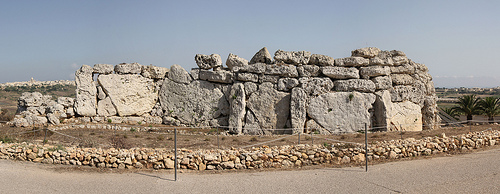

Location: Gozo Map
Open: 9am- 5pm daily
Ggantija Temple Complex located on an edge of Xagħra plateau on the island of Gozo was constructed in 4000- 3000 BC. Ggantija Temple Complex is one of the oldest man made structures in the World and certainly one of the oldest megalithic religious temples. The size of boulders of the Ggantija Temple Complex kept the layout and general appearance of the religious complex almost intact despite centuries of abandonment. Ggantija consists of two temples under one roof. Their entrance faces the south east. This arrangement is constant in other megalithic structures on islands of Malta, however there is no definitive theory that would explain the purpose or the meaning of this direction. Its blocks reach a height of 7.5 meters in places, each weighting up to 50 tons. Numerous round stones found on the site of Ggantija Temple Complex and around its periphery were used as rollers to bring massive slabs to the construction of the temple. The interior of the Southern temple consists of a limestone corridor with plastered walls leading to a the five apses where altars once stood for animal sacrifices. The North temple is smaller and contains four apses.
History
The approximately 5600 year old complex
consists of two assembled temples, the smaller of which was built
about 150 years later. The complex got its name from the giants
assumed at the time who must have built this structure. It was used
during the entire Chalolitic period from the Żebbuġ (approx. 3,800
BC) to the Tarxien phase (2,500 BC) at about the same time as
Mnajdra.
Construction
Each temple once had triliths as
entrance and passage constructions on the axis and consists of five
apses arranged like maple leaves, whereby the head niche of the
smaller north temple is only rudimentary. The position of the altars
can still be seen in some apses of the south temple and in one of
the north temple. The center aisle and the forecourt were probably
paved with slabs, at least the older three-apse temple of Kordin III
(picture see History of Malta) and remains in the aisle of the south
temple of Ġgantija refer to this.
The outer walls of the
facility are still over 6 meters high at one point. Due to the
volume of the coral limestone blocks, some weighing more than 50
tons, it can be assumed that the place of worship was originally
higher. The temples were roofed with cantilever vaults (as shown by
found models). However, the upper area was completely eroded over
time. The remains give a very good impression of the former height
of the building.
Location
The Ġgantija is located on a 115
m high hill above the place Xagħra (pronounced Shahra). It lies at
the end of the Xagħra Plateau and faces southeast. The place is
developed for tourism. The Brochtorff Circle and the Għar ta ’Għejżu
cave are also nearby, as well as the remains of the temple of Santa
Verna about a kilometer to the west. Until the discovery of the
approximately 11,000 year old temple on the Göbekli Tepe in Eastern
Anatolia, the Ġgantija was considered the oldest temple in the world
(made of carved stones), but the megalithic buildings in Brittany,
such as the Cairn of Barnenez, are centuries older.
Legends
According to legend, a giantess is said to have erected the building
in a single night while still holding her child in her arms.